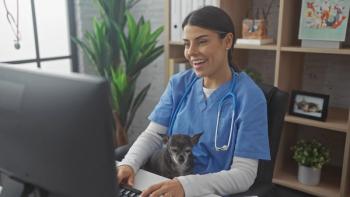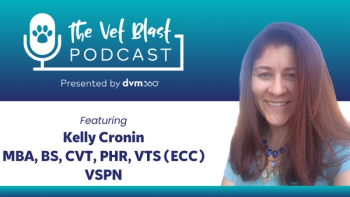
Veterinary Economics July 2012 Mailbox
"Kiss the dog," suggested Dr. Christina Winn in our May 2012 cover story about building strong doctor-patient-client relationships. Boy, did it generate a lot of letters. Here's a sampling, plus a response from Dr. Winn herself.
“Kiss the dog,” suggested Dr. Christina Winn in our May 2012 cover story about building strong doctor-patient-client relationships. Boy, did it generate a lot of letters. Here's a sampling, plus a response from Dr. Winn herself:
Story is a Winn-Winn
This will be the first and probably only time I ever comment on an article, but I simply had to. Christina hit the nail on the head. She is a brilliant writer who simply put it out there. I subscribe to the Dr. Winn principles of client contact every day in my practice. Hats off to you, Christina.
James St. Clair, DVM
Meriden Animal Hospital,
Meriden, Conn.
Say ‘no' to zoonosis
We would like to sound a cautious note in reference to the article “Kiss the dog.” While Dr. Winn does mention screening potential kissing partners for aggression, no mention is made of potential infectious disease transmission, both to and from the dog. The fur and oral cavity of dogs and cats harbor microorganisms that can cause disease in humans and other animals. In a recent report, three people contracted severe Pasteurella respiratory tract infections when caring for ill pets, including two who kissed sick cats. Conversely, being allowed to lick humans has been shown to be a risk factor for hospital visitation dogs acquiring methicillin-resistant Staphylococcus aureus, a canine and human pathogen.
A paper published last year in the peer-reviewed Centers for Disease Control and Prevention-based journal Emerging Infectious Diseases highlighted zoonotic risks associated with behavior such as kissing pets. There are no standard recommendations regarding kissing of animals, but the CDC strongly encourages pet owners to wash their hands after each interaction with their pets. Kissing a pet would presumably result in equal or greater microorganism transfer than petting, requiring some form of post-kissing hygiene, something that is unlikely to be performed.
We agree with the sentiment behind the article in terms of building a strong bond with clients and improving compliance. And we encourage veterinarians to express love and kindness to patients. However, kissing animal patients should be discouraged to avoid serious, unintended infectious complications for the protection of veterinarians, their patients, and their families.
Tony Johnson, DVM, Dipl. ACVECC
Lynn Guptill, DVM, PhD, Dipl. ACVIM
College of Veterinary Medicine, Purdue University, West Lafayette, Ind.
J. Scott Weese, DVM, DVSC, Dipl. ACVIM
Ontario Veterinary College, University of Guelph, Guelph, Ontario, Canada
Bruno Chomel, DVM, PhD
School of Veterinary Medicine, University of California Davis, Davis, Calif.
To view author Dr. Christina Winn's response, click the Next button below.
Author's response: Don't get me wrong
I would like to thank Drs. Johnson, Guptill, Weese, and Chomel for compiling and submitting their letter (published below). It opens up a wonderful discussion around using good judgment. All of their points are a reminder that we work in a field that contains infectious agents that can cause significant disease if good hygiene is disregarded.
I noticed that their letter quoted my article on kissing the dog, but left out the following sentence: “Hesitant to start smooching? Give the pet a high-five. This is a great alternative for those of you who have a phobia of kissing.”
I never noted that I kissed any of the animals on the lips. (And no, that's not my picture on the cover.) However, I now carry a travel-size container of baby wipes in the pocket of my lab coat to wipe after each kiss. If it cleans the bacteria from my twin's bums, then it should take care of whatever happened to be on my patient's head, right?
As for disease transmission, did you know that you are more likely to get toxoplasmosis from your own vegetable garden than from a cat? Risk assessment is always on my mind as well as risk-to-benefit ratios. If the coat of an animal contains an infectious agent, then the waiting room would be just as likely to transmit the disease as my hands or face.
Finally, my article wasn't really about kissing pets. That was the marketing tool used to emphasize that clients are more than just our next paycheck. They are people who put on their pants one leg at a time, just like we do. Treating them the way we want to be treated (with one tiny piece of that being affection shown to their pet) is the key to success, in my experience, as well as improved compliance and, in the end, better financial returns.
My own dog, Larry the pug, recently had surgery. The surgeon didn't kiss or hug him. She listened to his heart and didn't seem to mind when her pants got covered in fawn pug hair. She shook my hand and looked me in the eye when she spoke. She was kind and didn't seem bothered when I refused certain diagnostics. I felt heard, accepted, and supported. My bill wasn't too bad, but I would have paid more if she had asked. I have no idea if she read my article, but I bet she gets lots of thank-you cards. She totally gets being with people, and that was really what my article was about.
Christina Winn, DVM
Emergency and critical care clinician
Portsmouth, N.H.
Newsletter
From exam room tips to practice management insights, get trusted veterinary news delivered straight to your inbox—subscribe to dvm360.





